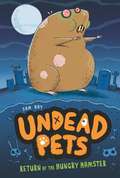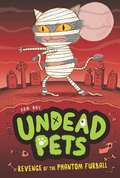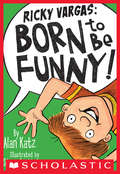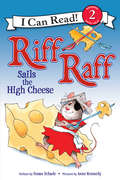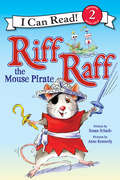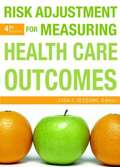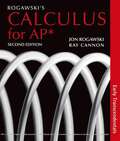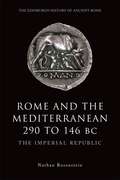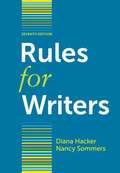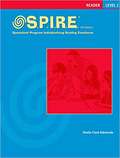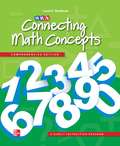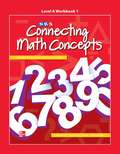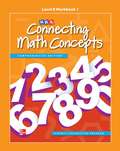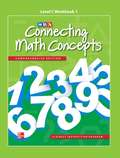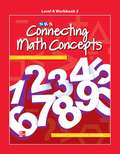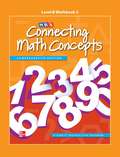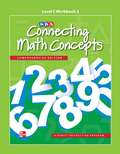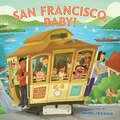- Table View
- List View
Return of the Hungry Hamster #1
by Simon Cooper Sam HayDumpling the hamster came to a dusty end inside a vacuum cleaner. He suspects that his owner Oliver's parents never admitted to their son that they were to blame for Dumpling's demise. Now the hamster needs Joe's help to reveal the truth - but there's a furry surprise awaiting them at Oliver's house...
Revenge of the Phantom Furball #2
by Simon Cooper Sam HayDisaster strikes when Bonsai the pug chases Pickle the cat into the street, where she is flattened by a car. But the fact that Pickle has (almost) shuffled off her mortal coil isn't her biggest concern; she is worried that Bonsai will pursue her sister Pebble into an early grave too, unless she and Joe teach the dog a lesson...
Review, Practice, Mastery of Common Core English Language Arts State Standards (Grade #6)
by Perfection LearningThis book presents the steps to reviewing, practicing and mastering English language arts in a fun and exciting way.
Ricky Vargas: Born to Be Funny! (Ricky Vargas)
by Alan KatzRicky Vargas IS the funniest kid in the world!Ricky Vargas is so funny he can make people snort milk out of their noses... even if they're not drinking anything!But it's not always easy to be so funny. And when the funniest kid in the world has his first un-funny day, Ricky has to figure out how to get back his amazing, world-famous sense of humor. Contains three hilarious Ricky Vargas stories in one book!
Riff Raff Sails the High Cheese (I Can Read Level 2)
by Susan SchadeShiver me whiskers! Someone has stolen the mice pirates’ most valuable loot: a great big chunk of cheese! Captain Riff Raff and the gang set out to retrieve the stolen booty, but can the cheese be seized?With colorful illustrations from Anne Kennedy and lively text from Susan Schade, Riff Raff Sails the High Cheese strengthens reading skills for beginning readers and buccaneers. Mice pirates and young readers use rhyming words and simple wordplay to solve the mystery of the missing cheese.Riff Raff Sails the High Cheese is a Level Two I Can Read book, geared for kids who read on their own but still need a little help.
Riff Raff the Mouse Pirate (I Can Read Level 2)
by Susan SchadeAhoy, mateys . . . and mice! Riff Raff the Mouse Pirate is setting off on a treasure hunt with his cheese-loving crew, but before they can find the treasure, the bold swashbucklers must find the missing clue!With colorful, detailed illustrations from Anne Kennedy and lively text from Susan Schade, Riff Raff the Mouse Pirate strengthens reading skills for beginning readers and young buccaneers. The mouse pirates use rhyming words to find their destinations, which help early readers recognize phonics sounds!Join in on the fun in this hilarious Level 2 I Can Read story, geared toward kids who read on their own but still need a little help.
Rikki-Tikki-Tavi
by Katherine Scraper Lori O'Dea Niki LeonidouA boy saves a mongoose. Then the mongoose saves him. Read to find out how!
Risk adjustment for Measuring Health Care Outcomes
by Lisa I. IezzoniA new chapter on the role of risk adjustment in managing healthcare organizations <p><p> New information on risk factors, including genetics and social and environmental determinants of health <p> Perspectives on electronic health records and new health information technologies <p> Explanations of new statistical methods for comparing provider outcomes and their implications for risk adjustment.
Rogawski's Calculus for AP*: Early Transcendentals
by Jon Rogawski Ray CannonNIMAC-sourced textbook
Rome and the Mediterranean 290 to 146 BC: The Imperial Republic
by Nathan RosensteinA compelling account of how Rome became supreme power in Europe and the Mediterranean world. The book highlights the significance of Rome's success in the wars against Pyrrhys, Carhage, the Hellenistic kingdoms and in Spain that led to empire, and it shows how the Republic's success in conquering an empire changed the conquerors.It is unusual in focusing on a discrete, vital period in Roman history rather than attempting to cover all of it or even just the Republic.
Rules for Writers (7th Edition)
by Diana Hacker Nancy SommersRules for Writers is a college writer's companion that covers writing, grammar, research, and documentation in an extremely affordable and portable spiral-bound format. From the best-selling family of handbooks,Rules has consistently been the best value for college writers. Now it's even more so. The Seventh Edition actually teaches students how to make better use of their handbook. With new material about how to integrate the handbook into lessons and class activities,Rules for Writers is an even more useful tool for instructors. Read the preface.
S.P.I.R.E. Level 5 (Third Edition)
by Sheila Clark-EdmandsThis S.P.I.R.E.® Level 3 (spire) decodable reader is perfect for early readers and those who need practice reading simple books with basic phonics concepts. This book includes words with suffix -ed (melted, smelled, winked).
SPIRE Reader, Level 2
by Sheila Clark-EdmandsSPIRE Level 2 Reader 3/E. These interactive books are instructional. They provide plain text, without illustrations to help struggling readers focus and attend to the text. Inside you will find 100% decodable reading passages, word lists, and sentences for the application of decoding strategies, including marking up the text.
SPIRE Reader, Level 3
by Sheila Clark-EdmandsSPIRE Level 3 Reader 3/E. These interactive books are instructional. They provide plain text, without illustrations to help struggling readers focus and attend to the text.
SRA Connecting Math Concepts, Comprehensive Edition, Textbook, Level C
by Douglas Carnine Siegfried Engelmann Bernadette KellyNIMAC-sourced textbook
SRA Connecting Math Concepts, Comprehensive Edition, Workbook 1, Level A
by Siegfried Engelmann Owen EngelmannNIMAC-sourced textbook
SRA Connecting Math Concepts, Comprehensive Edition, Workbook 1, Level B
by Douglas Carnine Siegfried Engelmann Owen EngelmannNIMAC-sourced textbook
SRA Connecting Math Concepts, Comprehensive Edition, Workbook 1, Level C
by Douglas Carnine Siegfried Engelmann Bernadette KellyNIMAC-sourced textbook
SRA Connecting Math Concepts, Comprehensive Edition, Workbook 2, Level A
by Siegfried Engelmann Owen EngelmannNIMAC-sourced textbook
SRA Connecting Math Concepts, Comprehensive Edition, Workbook 2, Level B
by Douglas Carnine Siegfried Engelmann Owen EngelmannNIMAC-sourced textbook
SRA Connecting Math Concepts, Comprehensive Edition, Workbook 2, Level C
by Douglas Carnine Siegfried Engelmann Bernadette KellySRA Connecting Maths Concepts Comprehensive Edition has been revised for Levels A-F and students in Grades K-5. This program gives students who are at-risk of falling behind or who have already significantly fallen behind the chance to catch up and learn significant mathematics. New digital resources accompany the program including Practice Software, Board Displays and eBook Teacher Guides and Presentation Books.
Samajik Vigyan Semester 2 class 8 - GSTB: સામાજિક વિજ્ઞાન દ્વિતીય સત્ર ધોરણ ૮ - જીએસટીબી
by Gstbઆ પાઠ્યપુસ્તકને અનુભવ, ચિંતન ઉપયોજન અને નિષ્કર્ષ તારવવાને લગતી પ્રવૃત્તિઓ દ્વારા શિક્ષણને અધ્યતાકેન્દ્રી બનાવવાનો પ્રયાસ કર્યો છે. વિદ્યાર્થીઓ વ્યક્તિગત અને સામુહિક રીતે જૂથમાં અધ્યયન કરે તે જરૂરી છે. એવી અધ્યયન પ્રક્રિયામાં મદદરૂપ થાય તેવાં પાઠયપુસ્તકો તૈયાર કરવાનો પ્રયત્ન કરવામાં આવ્યો છે. પાઠયપુરત્તક એ એક સહજ ઉપલબ્ધ અધ્યયન સામગ્રી છે.પાઠયપુસ્તક દ્વારા પ્રવૃત્તિલક્ષી શિક્ષણની બાબત નાવીન્યપૂર્ણ રીતે પ્રસ્તુત કરવામાં આવી છે.તે દ્વારા અધ્યયન-અધ્યાપન પ્રક્રિયા રોચક બનશે. પ્રસ્તુત પાઠ્યપુસ્તક પુસ્તક માં 1 થી 14 પાઠ છે અને સાથે પુનરાવર્તન 1 અને 2 છે.
San Francisco, Baby!
by Ward JenkinsTwo babies go on two big-city adventures, and there are so many exciting sights to see! In New York, Baby!, Times Square, Broadway, Central Park, and the Metropolitan Museum of Art number among the top destinations; while in San Francisco, Baby!, the Golden Gate Bridge, Fisherman's Wharf, and Alcatraz are some of the main attractions. Rhyming text and charming illustrations make these picture books perfect for babies—and parents—who are always on the go, or who have big-city dreams!
Sanskrit Semester 1 class 6 - GSTB: संस्कृत (प्रथम सत्र ) कक्षा ६
by Kanubhai Karkar Narendra Rawal Pravinchandra Jani Prafulbhai Scissorsપાઠ1 માં ચિત્ર દ્વારા સરસ માહિતી આપેલ છે જેમાં પશુઓ ના ચિત્રો દ્વારા સંસ્કૃત ભાષાની સમજ આપવામાં આવી છે. ચિત્રપદાની 1 થી 4 સરસ માહિતી સભર છે.પાઠ 2 ચિત્ર દ્વારા વાર્તા ની સરસ સમજ આપેલ છે. પાઠ 3 માં સંસ્કૃત ભાષા દેવનાગરી લિપિમાં લખાય છે. આપણી માતૃભાષાની લિપિ દેવનાગરી લિપિમાંથી જ આવી હોવાથી શિરોરેખાને બાદ કરતાં કેટલાક મૂળાક્ષરો દેવનાગરી લિપિની જેમ લખાય છે, જેથી તેનો પરિચય કેળવવો મુશ્કેલ નથી. કેટલાક મૂળાક્ષરોના વળાંકોમાં થોડીક ભિન્નતા જોવા મળે છે, તે સમજાવેલ છે,પાઠ 4 માં સંખ્યા જ્ઞાન આપેલ છે. આરીતે 9 પાઠ સરસ માહિતી સભર છે. પાઠ 9 માં ઘડિયાળ માં સમય જોવા અને સંસ્કૃત કહેવાનું સીખ્વાડવામાં આવ્યું છે. સાથે પુનરાવર્તન1 અને 2 પણ છે.
